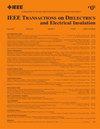Voltage Endurance Characteristics of Cross-Linked Polyethylene–Silicone Rubber Interface Subjected to DC and AC Voltages
IF 2.9
3区 工程技术
Q2 ENGINEERING, ELECTRICAL & ELECTRONIC
IEEE Transactions on Dielectrics and Electrical Insulation
Pub Date : 2024-09-10
DOI:10.1109/TDEI.2024.3456773
引用次数: 0
Abstract
When designing and inspecting power equipment, it is crucial to consider not only the distinctions between ac, dc, and ac–dc hybrid systems but also the voltage endurance characteristics. However, scientific design and research on the mechanism responsible for the breakdown of solid-solid interfaces (e.g., cable joints), which are weak points in electrical insulation, is lacking. Therefore, in this study, the insulating strength of the interface in relation to the electric field form and voltage endurance time is examined. Specifically, the increase in the insulation strength and the ablation of cross-linked polyethylene–silicone rubber (XLPE–SiR) interfaces are investigated based on the ramped breakdown and step-stress methods. The results illustrate that the dc breakdown strength surpasses the ac breakdown strength, while the ac field fails to reach the composite (ac–dc) electric field breakdown strength. Furthermore, the interfacial breakdown strength is influenced by both long-term and transient stresses. The interfacial breakdown process can be divided into three stages. The breakdown voltage increases in the short term with decreasing step-up rate. Step-stress tolerance experiments and simulations indicate that the highly distorted electric field at asperity contacts leads to cavity discharges and electrothermal losses, resulting in the ablation of the asperities on the rough surface. The electric field distortion decreases with decreasing interface roughness, leading to an increase in breakdown strength. Moreover, as the endurance time increases, the improvement of the ac breakdown strength is more significant than that of the composite electric field, while the dc breakdown strength shows the least improvement.交联聚乙烯-硅橡胶界面在直流和交流电压下的耐压特性
在设计和检查电力设备时,不仅要考虑交流、直流和交直流混合系统的区别,还要考虑其耐压特性,这一点至关重要。然而,对于电气绝缘薄弱环节——固-固界面(如电缆接头)的击穿机理,缺乏科学的设计和研究。因此,在本研究中,研究了界面的绝缘强度与电场形式和耐压时间的关系。具体地说,基于梯度击穿和阶跃应力方法研究了交联聚乙烯-硅橡胶(XLPE-SiR)界面绝缘强度的增加和烧蚀。结果表明:直流击穿强度超过交流击穿强度,而交流电场击穿强度达不到交直流复合电场击穿强度;此外,界面击穿强度受长期应力和瞬态应力的共同影响。界面击穿过程可分为三个阶段。击穿电压在短期内随升压速率的减小而增大。阶跃应力容限实验和模拟结果表明,在粗糙表面上,高度畸变的电场会引起空腔放电和电热损失,从而导致粗糙表面上的凹凸不平被烧蚀。电场畸变随界面粗糙度的减小而减小,导致击穿强度的增加。而且,随着续航时间的增加,交流击穿强度的提高比复合电场的提高更显著,而直流击穿强度的提高最小。
本文章由计算机程序翻译,如有差异,请以英文原文为准。
求助全文
约1分钟内获得全文
求助全文
来源期刊
CiteScore
6.00
自引率
22.60%
发文量
309
审稿时长
5.2 months
期刊介绍:
Topics that are concerned with dielectric phenomena and measurements, with development and characterization of gaseous, vacuum, liquid and solid electrical insulating materials and systems; and with utilization of these materials in circuits and systems under condition of use.

 求助内容:
求助内容: 应助结果提醒方式:
应助结果提醒方式:


